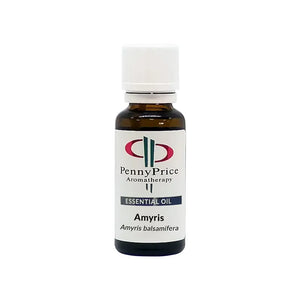Your Cart is Empty
- Shop
- Therapist Discount
- About Us
- FAQ, Blog & Downloads
- Courses
- Saturday Club
- Free Blending Series
- Product Catalogue
- Contact Us
- 01455 251020
- Login




 Latin Name: Amyris balsamifera
Latin Name: Amyris balsamifera
Plant Family: Rutaceae
Extraction: Distillation of the tree & wood
Country of Origin: Haiti
Synonyms: West Indian sandalwood, West Indian rosewood
Experience the cleansing power of Amyris Essential Oil! Known as 'candle wood' for its oil-rich wood. Traditionally used as an antiseptic and for its sedative qualities. A base note that blends harmoniously with lavandin, citronella, and wood oils like cedarwood.
Amyris essential oil is a pale yellow slightly viscous liquid with a musty, mildly woody scent. It is acclaimed to be the West Indian Sandalwood - but it does not belong to the same family. The quality of Amyris essential oil depends on the age and moisture of the tree as well as different regions, as a result, this can produce slightly different oil. It can be found growing wild on the mountain slopes of Haiti and is often found in small thickets. It is an evergreen tree that produces lovely white flowers, however, it's the bark that actually produces valuable resinous fluid.
Amyris, Natural Pure Essential Oil - Available in 10ml, 25ml, 50ml & 100ml.
Key oil benefit: Cleansing
Traditionally used by aromatherapists as an antiseptic and for its sedative qualities. Amyris was called 'candle wood' because of its high oil content in the wood, it burns like a candle. It was used by fishermen and traders as a torch and also makes excellent furniture wood.
Amyris essential oil is a base note and it blends well with, lavandin, citronella and wood oils such as cedarwood
Amyris Essential Oil Safety Data
Essential oils are very powerful and should be used with caution. Here are a few tips that you may find useful, although we advise that you consult a fully qualified, registered aromatherapist who will be able to advise you on the safe methods of use. Why not give us a ring at 01455 251020 or email info@penny-price.com if you are unsure we will be happy to help.
Inhalation:Undiluted essential oils may be inhaled from a tissue or a pillow (4-6 drops). Alternatively, they can be inhaled from a bowl of hot water (3 or 4 drops) or a diffuser (see table below), but avoid this if asthmatic. Never inhale essential oils directly from the bottle.
Shampoo and Bath Foam: Create unique aromatherapy bath foams or shampoos by mixing up to 30 drops of your own essential oil blend into 100ml of a suitable bath foam base or shampoo base.
Skincare Cream: Essential oils can be added to vegetable-based creams and then developed into facial products or topical creams. Do not add more than 15 drops of essential oil to 50ml of your base cream.
Pregnancy: Essential oils are best avoided during the first months of pregnancy. After the third month, many oils can be used safely and effectively. If in doubt, always consult a qualified aromatherapist.
Bath, Massage, Vaporiser: See the table below, which gives the correct amounts to use depending on age, and a brief guide on how to use.